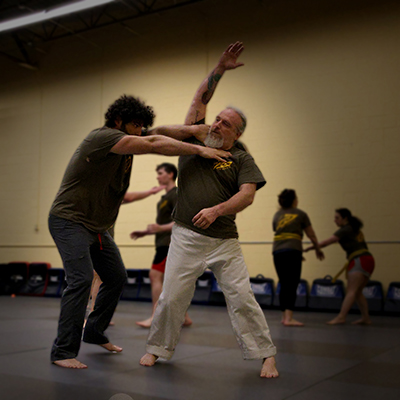Krav Maga History

History of Krav Maga
Krav Maga was not the first Israeli martial art/fighting system. The first was an approach and method known as KAPAP, an acronym for “Krav Panim A Panim”, meaning “fighting face to face”, in Hebrew. This was a system taught and used by the Haganah, an underground defense force, that protected Jewish settlers in Palestine, and fought for the creation of the state of Israel in the 1930’s and 1940’s. When Israel gained independence, in 1948, members of the Haganah, became the core of the IDF (Israeli Defense Forces). The KAPAP, approach was a conceptual one, rather than a rigid and strict set of techniques; an approach which Krav Maga has adopted and continues to use. Rather than having the system be defined by a catalog of unchanging techniques, fighting concepts and principles allow techniques to be created and evolved, and if necessary, discarded as better ones are created, or become obsolete e.g., in the 1930’s it was effective and appropriate to grab the barrel of a rifle, as both the caliber of ammunition and the rate of fire meant that the barrel rarely heated up to a degree where it couldn’t be held, however this is not the case with modern weapons, and so long barrel gun disarming had to change, adapt and evolve – something that could happen, within a framework that uses concepts and principles to guide and create solutions.
The term Krav Maga was used by Imi Lichtenfeld, an instructor in the Haganah, to refer to his approach and interpretation of KAPAP. Having grown up fighting fascist street gangs in his native Bratislava (before emigrating to Israel, or Palestine as it was then known), he had seen how individuals when attacked would instinctively try and block attacks, using natural and inherent movements, even if they had trained in boxing or other martial arts etc. When surprised and/or overwhelmed their formal training tended to not be effective and they defaulted to their instincts. Taking this idea, he designed an approach that worked with these natural movement and reflexive responses e.g., if the throat was attacked via a strangulation, a person’s natural instinct is to try and grab the arm and pull it away etc., this natural movement then became the starting point for the solution on escaping a strangulation. By working in this manner and keeping the conceptual approach that distinguished KAPAP, he created what was effectively a “new” version or variant, that over time came to be known as Krav Maga; up until the 1960’s the terms Krav Maga and KAPAP were used interchangeably within the IDF.
When Imi left the IDF in 1964, he started to modify and develop the approach for law-enforcement and civilians. Within the IDF, his successor Eli Avikzar, took over the running and development of the Krav Maga program, later referring to his approach as Krav Magen (Combat Shield), in order to differentiate from other systems of Krav Maga – something that is common within Israel i.e., there isn’t one common system of Krav Maga; all systems have at their core the same concepts and principles, however this allows programs to develop different solutions to attacks and threats, based on the contexts within which their members operate e.g., if an agency or unit is working in law-enforcement and/or private security they may emphasize control and restraint solutions, whereas for infantry personnel there may be more emphasis on how to block and strike with a rifle etc. For civilians the need to disengage after creating an opportunity to do so may be emphasized etc.
Although all instructors teaching hand-to-hand fighting within the IDF do so under the umbrella term of Krav Maga, outside they may use other terms to refer to what they teach, such as Haganah Amit, meaning self-defense, or Hisardut (meaning survival) as Dennis Hanover does. Dr Hanover, who emigrated to Israel from South Africa, is perhaps one of the most influential figures in Israeli Martial Arts and may have trained more IDF instructors – especially those working with specialist and elite units – than any other individual. His approach blended traditional Karate, Judo and Ju-Jitsu to create what in many ways was the first Mixed Martial Art (MMA). Head Instructor, Gershon Ben Keren, is a 3rd Degree Black Belt in Hisardut, and passed the Hisardut instructor course.
The Krav Maga Yashir (meaning “Direct Contact Combat in Hebrew), reflects Head Instructor, Gershon Ben Keren’s training with a number of different Krav Maga instructors in Israel, including Dennis Hanover, Miki Assulin, Eyal Yanilov, Avi Moyal and Haim Gidon. The Krav Maga Yashir syllabus contains solutions to unarmed and armed assailants, both when standing and/or on the ground, and teaches strategies and tactics to deal with both individual and multiple attackers etc. Having a complete and coherent syllabus, means that students don’t need to supplement their training by learning Muay Thai, BJJ and/or any other systems, which may at their heart promote approaches to fighting that are at odds with that of Krav Maga.
Our school is located 15 minutes south of Peabody on I-95 (Exit 54 I-95 South, Exit 53 I-95 North). Our class schedule can be accessed by clicking here. The best way to start training with us is to take one of our introductory seminars/classes. To see when these are running, and to book your place please use the button below.
Book beginner Class